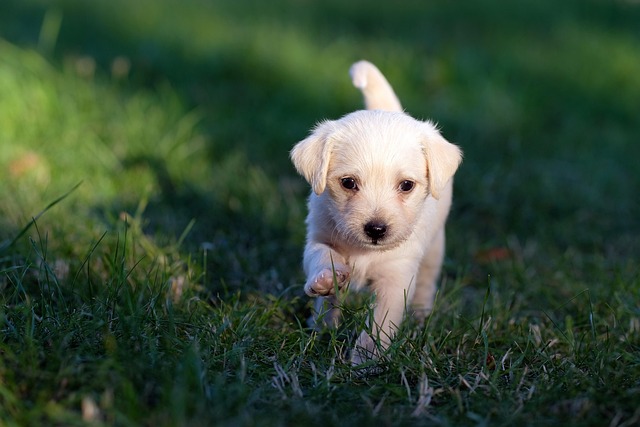Puppies are adorable — that part’s easy.
What’s a little less cute? Figuring out how to train one, especially if you’ve never had a puppy before.
The good news: training doesn’t have to be overwhelming. With consistency, patience and plenty of treats, you can help your puppy grow into a confident, well-mannered adult dog.
Let’s walk through the basics, step by step.
Why Puppy Training Matters
Training early gives you the best chance of raising a well-behaved dog. Older puppies and adult dogs can still learn, of course — but it’s harder to undo bad behaviors like jumping, barking or chewing once they’ve had months to practice them.
Training isn’t just about good manners, either. It’s also mental enrichment, which keeps puppies happier and healthier overall.
What Your Puppy Should Learn in the First Six Months
During the early months, focus on these core areas:
- Socialization
- Potty training
- Crate training
- Basic obedience (sit, stay, come)
- Bite inhibition
- Impulse control
- Leash manners
- Preventing separation anxiety
It may sound like a lot, but puppies learn quickly when training is fun and consistent.
Puppy Training Essentials
Before you begin, make sure you have:
A flat collar or harness + non-retractable leash
These are important for walks and leash manners.
A variety of treats
Use three types:
- Low value: kibble
- Medium value: soft chews
- High value: cooked chicken or turkey — reserved for the most important moments
A treat pouch
Keeping treats handy makes training easier and more effective.
Positive reinforcement works best when rewards come instantly.
Try this treat pouch from Amazon
And these training treats from Amazon
Here is a roundup of some of the best puppy training treats.
How to Train Your Puppy: The Positive Reinforcement Way
Positive reinforcement means rewarding your puppy when he does something right. Rewards can include:
- Praise
- Treats
- Toys
- A clicker
- Petting
- Playtime
Your puppy learns: Good choices lead to good things.
Avoid negative reinforcement — punishing your puppy when he does something you don’t like, because that could be harmful or even inhumane, and can damage trust and often makes behavior worse. Instead, ignore or redirect behavior you don’t want.
Now let’s cover the big training milestones.
Potty Training
Potty training is one of the first — and easiest — skills to teach.
Your schedule is the secret to success:
Take your puppy outside every 1–2 hours and stay out for at least 15 minutes.
Bring your puppy out:
- First thing in the morning
- After meals
- After naps
- After playtime
- Before bed
Praise and reward immediately after he finishes.
Puppy pads can be used as a backup in a confined area, but your main goal should always be consistent outdoor trips. Remove pads once you’ve had two accident-free weeks.
You can learn more about house training your puppy here.
Leash Training
To begin leash training your puppy, you’ll first need the right equipment: a leash, a harness and a collar for his ID tags (in case he slips off his leash while out walking).
Start by getting your puppy used to wearing his harness indoors. Attach a dragline (a leash without a loop) so he can practice walking with something trailing behind him.
To teach heelwork:
Hold a treat near his nose and guide him to your side. Reward when he stays in the correct position.
If he pulls — stop walking.
If he weaves side to side — stop walking.
If he lags — stop and let him come to you, then reward.
Consistency teaches him that staying close is what makes the walk continue.
Check out our detailed step-by-step leash training guide here.
Crate Training
A crate should feel safe and cozy, like a den — never punishment.
Start by:
- Choosing the right-sized crate
- Adding soft bedding and safe toys
- Letting your puppy explore with the door open
- Rewarding calm behavior inside the crate
Once he’s relaxed, close the door for short periods while you stay nearby. When he can rest comfortably with the door closed, try brief practice outings.
Learn more about how to crate train your puppy here. And if your puppy is having trouble adjusting to the crate, here's what to do if your puppy won’t stop crying and barking while he’s crated.
Teaching Sit, Stay and Come
Sit
- Hold a treat close to your puppy’s nose
- Slowly raise it above his head
- As his bottom touches the ground, say “yes” and reward
- Add the cue “sit” once he understands the motion
Stay
- Ask for a sit or down
- Hold your hand out, palm facing your puppy
- Reward after a few seconds
- Gradually add time, then add the verbal cue “stay”
Come
- Say your puppy’s name
- Reward when he looks at you
- Call him, and praise generously when he runs to you
- Increase distance slowly and keep it fun
You can learn how to train your puppy to follow all seven basic cues with this helpful how-to.
Stopping Puppy Biting
Puppies bite to play, explore and soothe teething gums — it’s normal, but needs guidance.
To reduce nipping:
- Make sure your puppy gets enough exercise
- Always play with a toy, not your hands
- If he bites you, say “OW!” loudly and stop the game
- Redirect to a toy and reward when he chews the right thing
If you’re interested in learning more about training your puppy not to bite, check out this how-to.
Common Puppy Training Challenges
Training takes consistency — and puppies go through many developmental stages that can cause temporary setbacks.
Some tips:
- Expect regression (it’s normal!)
- Stick with positive methods
- Avoid misleading online advice
- Stay patient — puppies are little babies learning big things
If you feel stuck, reach out to a certified trainer or behaviorist. A little professional help can make training smoother for both you and your pup.
The Bottom Line
With time, structure, patience and love, your puppy can grow into a confident, well-mannered dog. Training isn’t just about good behavior — it strengthens your bond and gives your puppy the mental enrichment he needs to thrive.
You’ve got this — and your puppy is ready to learn.
We independently pick all the products we recommend because we love them and think you will too. If you buy a product from a link on our site, we may earn a commission.



